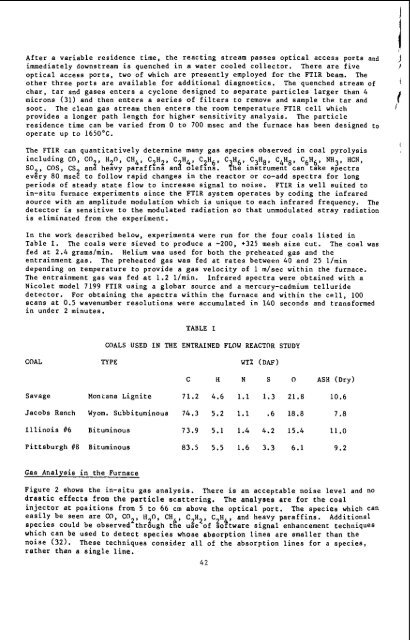the coking properties of coal at elevated pressures. - Argonne ...
the coking properties of coal at elevated pressures. - Argonne ...
the coking properties of coal at elevated pressures. - Argonne ...
You also want an ePaper? Increase the reach of your titles
YUMPU automatically turns print PDFs into web optimized ePapers that Google loves.
After a variable residence time, <strong>the</strong> reacting stream passes optical access ports and<br />
immedi<strong>at</strong>ely downstream is quenched in a w<strong>at</strong>er cooled collector. There are five ?<br />
optical access ports, two <strong>of</strong> which are presently employed for <strong>the</strong> FTIR beam. The<br />
o<strong>the</strong>r three ports are available for additional diagnostics. The quenched stream <strong>of</strong> I<br />
char, tar and gases enters a cyclone designed to separ<strong>at</strong>e particles larger than 4<br />
microns (31) and <strong>the</strong>n enters a series <strong>of</strong> filters to remove and sample <strong>the</strong> tar and (<br />
soot. The clean gas stream <strong>the</strong>n enters <strong>the</strong> room temper<strong>at</strong>ure FTIR cell which<br />
/<br />
provides a longer p<strong>at</strong>h length for higher sensitivity analysis. The particle<br />
residence time can be varied from 0 to 700 msec and <strong>the</strong> furnace has been designed to<br />
oper<strong>at</strong>e up to 1650’C.<br />
The FTIR can quantit<strong>at</strong>ively determine many gas species observed in <strong>coal</strong> pyrolysis<br />
including CO, CO , H20, CH4, CZH2, C H4, C2H6, C4H8s C6H6, NH3, HCN,<br />
SO2, COS, CS ani heavy paraffins an% olefins. C$Et’i:ikment can take spectra<br />
2<br />
every 80 msec to follow rapid changes in <strong>the</strong> reactor or co-add spectra for long<br />
periods <strong>of</strong> steady st<strong>at</strong>e flow to increase signal to noise. FTIR is well suited to<br />
in-situ furnace experiments since <strong>the</strong> FTIR system oper<strong>at</strong>es by coding <strong>the</strong> infrared<br />
source with an amplitude modul<strong>at</strong>ion which is unique to each infrared frequency. The<br />
detector is sensitive to <strong>the</strong> modul<strong>at</strong>ed radi<strong>at</strong>ion so th<strong>at</strong> unmodul<strong>at</strong>ed stray radi<strong>at</strong>ion<br />
is elimin<strong>at</strong>ed from <strong>the</strong> experiment.<br />
In <strong>the</strong> work described below, experiments were run for <strong>the</strong> four <strong>coal</strong>s listed in<br />
Table 1. The <strong>coal</strong>s were sieved to produce a -200, +325 mesh size cut. The <strong>coal</strong> was<br />
fed <strong>at</strong> 2.4 grams/min. Helium was used for both <strong>the</strong> prehe<strong>at</strong>ed gas and <strong>the</strong><br />
entrainment gas.<br />
The prehe<strong>at</strong>ed gas was fed <strong>at</strong> r<strong>at</strong>es between 40 and 25 l/min<br />
depending on temper<strong>at</strong>ure to provide a gas velocity <strong>of</strong> 1 m/sec within <strong>the</strong> furnace.<br />
The entrainment gas was fed <strong>at</strong> 1.2 l/min. Infrared spectra were obtained with a<br />
Nicolet model 7199 FTIR using a globar source and a mercury-cadmium telluride<br />
detector. For obtaining <strong>the</strong> spectra within <strong>the</strong> furnace and within <strong>the</strong> cell, 100<br />
scans <strong>at</strong> 0.5 wavenumber resolutions were accumul<strong>at</strong>ed in 140 seconds and transformed<br />
in under 2 minutes.<br />
TABLE I<br />
COALS USED IN THE ENTRAINED FLOW REACTOR STUDY<br />
COAL TYPE UT% (DAF)<br />
c H N S 0 ASH (Dry)<br />
Savage Montana Lignite 71.2 4.6 1.1 1.3 21.8 10.6<br />
Jacobs Ranch Wyom. Scbbituminous 74.3 5.2 1.1 .6 18.8 7.8<br />
Illinois P6 Bituminous 73.9 5.1 1.4 4.2 15.4 11.0<br />
Pittsburgh 18 Bituminous 83.5 5.5 1.6 3.3 6.1 9.2<br />
Gas Analysis in <strong>the</strong> Furnace<br />
Figure 2 shows <strong>the</strong> in-situ gas analysis. There is an acceptable noise level and no<br />
drastic effects from <strong>the</strong> particle sc<strong>at</strong>tering. The analyses are for <strong>the</strong> <strong>coal</strong><br />
injector <strong>at</strong> positions from 5 to 66 cm above <strong>the</strong> optical port. The species which can<br />
easily be seen are CO, C02, H20, CH , C2H2, C H and heavy paraffins. Additional<br />
species could be observed through tke use <strong>of</strong> to4;ware signal enhancement techniques<br />
which can be used to detect species whose absorption lines are smaller than <strong>the</strong><br />
noise (32). These techniques consider all <strong>of</strong> <strong>the</strong> absorption lines for a species,<br />
ra<strong>the</strong>r than a single line.<br />
42<br />
1<br />
I

















